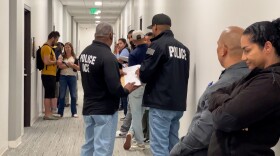San Diego County officials got a peek Wednesday at what a carbon-neutral future would look like — and it involves a lot of electricity.
County staff and researchers from UC San Diego and around the country have been mulling over how the region can achieve a net-zero carbon future by 2045. That is the deadline set by the state of California.
Getting there means changing all sectors of the economy that generate greenhouse gasses. That includes housing, business and transportation.
RELATED: San Diego County considers paving the way for a net carbon neutral future
“We do need to get to a carbon-neutral economy,” said Nathan Fletcher, chair of the San Diego County Board of Supervisors.
Fletcher said the fossil fuel industry lied to the public about the impact of their products for years and now local leaders have to make tough choices.
“We also have to do that in a way that recognizes the vital contribution of workers. And recognizes the vital role that they play,” Fletcher said. “You cannot advance an environmental agenda while displacing a good middle-class job.”
And that is just one issue on the path to decarbonization.
The regional plan calls for a massive increase in the amount of renewable energy generated in the county. Most of that would come from utility-scale solar and wind projects.
And the draft blueprint takes aim at the transportation sector.
UC San Diego School of Global Policy and Strategy Associate Dean Gordon McCord says cars and trucks need to be electric, and existing plans drawn up by the San Diego Association of Governments do not account for a fast enough transition.
“SANDAG’s estimates show a reduction of 26% by 2030 — 33 % by 2035, and 34% by 2050, so there will be a gap to close there," McCord said.
McCord’s calculations estimate half of the region’s vehicles need to be electric by 2030 and all by 2050.
RELATED: San Diego scientists give mixed reaction to climate summit
“I don’t believe cars are the problem,” said Jim Desmond, a San Diego County supervisor representing the fifth district.
Desmond is an outspoken critic of SANDAG’s push to get drivers out of their cars and into mass transit.
“Individual vehicles are not the problem. It’s the emissions,” Desmond said. “And I think we need to move towards incentives for cleaner hydrogen, electric vehicles, whatever, for tractors, trucks all equipment.”
Desmond also reminded the panel that the region has a housing shortage and the decarbonization plan should not rule out developments in rural areas.
Environmentalists argue rural developments put carbon into the air by forcing people to drive more.
They also see the decarbonization plan as an aspirational strategy that shows a zero-carbon future is possible.
“We know that our individual local institutions aren’t doing enough to slash emissions fast enough to meet the scale and scope of the climate crisis,” said Noah Harris, a spokesman for the Climate Action Campaign. “So part of our optimism is we’re really starting to see major regional collaboration when it comes to climate solutions, and climate justice and climate strategies.”
RELATED: Clean Air Day puts focus on pollution in San Ysidro
The draft blueprint does not ignore the county’s most vulnerable residents.
The San Diego Green New Deal coalition turned out to lobby for a carbon-free future, but they want planners to remember underserved communities.
“Our communities have endured the worst of systematic racism, environmental injustice, and economic exclusion and should be at the center of every conversation and decision,” said Bertha Rodriguez of the San Diego Green New Deal coalition.
That got a warm reception from Supervisor Nora Vargas who has worked hard to make sure environmental justice is part of the county’s planning processes, something she saw in the draft plan.
“It understands the need, the connection between the environment and climate justice and our economic development potential. To me that’s really critical in the work that we’re doing,” Vargas said.
The next milestone in the decarbonization plan is a review of the economic impact of making the changes needed to hit the climate goals. That’ll happen in March.
Supervisors will likely consider a final plan by summer.






